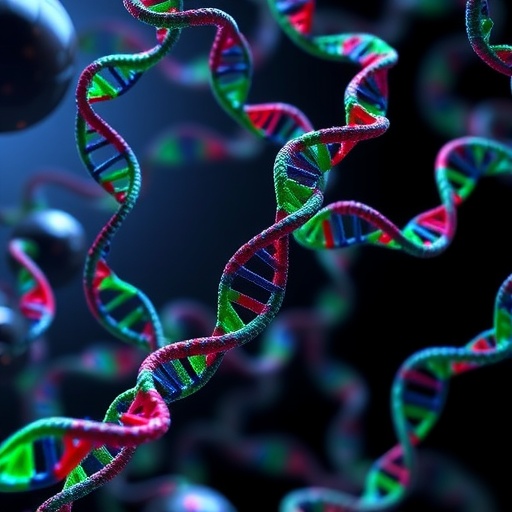In a groundbreaking study published in Nature, researchers have unveiled the pivotal role of specific genetic elements in preserving extrachromosomal DNA (ecDNA) within cancer cells, shedding light on a critical driver of oncogene amplification and tumor evolution. This revelation illuminates the mechanisms behind how ecDNA contributes to cancer’s aggressive growth and therapy resistance, offering fresh avenues for targeted interventions.
Extrachromosomal DNA, circular DNA molecules separate from the chromosomes, are notorious for harboring oncogenes that fuel cancer progression. Unlike chromosomal DNA, ecDNAs replicate and segregate imperfectly during cell division, often resulting in their rapid loss from daughter cells. Until now, the processes that ensure ecDNA retention and amplification despite this challenge remained poorly understood, limiting our grasp of cancer biology at a genomic level.
The team employed advanced evolutionary simulations to dissect the interplay between ecDNA retention fidelity and natural selection in the context of tumor cell populations. Their models revealed that ecDNAs could only achieve significant amplification when the fidelity of their retention during mitosis exceeded 90%. If retention rates dropped below this threshold, even potent selective advantages conferred by oncogenes failed to stabilize ecDNA presence, highlighting that near-perfect mitotic retention is essential for ecDNA-driven oncogenic expansion.
Intriguingly, this theoretical minimum retention rate mirrored experimental observations garnered through cutting-edge live-cell imaging. A single retention element embedded within ecDNAs was sufficient to confer a roughly 10% failure rate per mitosis, confirming the simulation predictions. This tight correlation underscores the biological importance of retention elements in sustaining the oncogenic functions of ecDNA lineages within tumors.
Further analyses of patient tumor samples revealed that nearly all ecDNA amplicons containing oncogenes also carried retention elements, with 98% co-amplification observed. These retention elements frequently co-localized with oncogenes on large ecDNA segments often exceeding one megabase in size, vastly larger than the oncogene sequences themselves. This excess DNA likely harbors multiple retention elements, collectively enhancing mitotic stability and promoting persistent oncogene expression.
Contrastingly, linear chromosomal amplifications displayed more variable sizes and a sparser distribution of retention elements, suggesting a fundamental difference in how ecDNA and chromosomal amplifications evolve and maintain themselves in cancer cells. DNA segments lacking retention elements were commonly linked to those with retention elements on ecDNAs, but such associations were absent in linear amplifications, reinforcing the specific structural significance of retention elements for extrachromosomal maintenance.
Investigating spatial patterns, the study found that the local density of retention elements inversely correlated with ecDNA amplicon size. Genomic regions rich in retention elements tended to give rise to smaller ecDNA circles, whereas low-density areas favored larger ecDNA amplicons to encompass at least one retention element. This nuanced relationship influences the architecture of ecDNA and indicates that cancer cells exploit retention element distribution to optimize oncogene amplification efficiently.
Beyond tumor contexts, the researchers also explored the presence of retention elements in smaller, nonclonal extrachromosomal circular DNAs—known as microDNAs—which are prevalent in normal somatic tissues but typically not amplified. Remarkably, although most microDNAs lacked retention elements, there was a significant enrichment of these elements within microDNAs compared to random genomic segments across diverse human cell lines, implicating retention elements even in the persistence of small circular DNAs outside cancerous settings.
Epigenetic profiling of retention elements demonstrated lower DNA methylation levels compared to matched genomic intervals, suggesting a unique chromatin environment that might favor retention element function. Targeted methylation of retention elements using CRISPRoff technology reduced ecDNA tethering within cells, highlighting the critical role of their epigenetic state in maintaining ecDNA stability.
Functionally, these findings converge on a model in which retention elements serve as molecular anchors securing ecDNA during mitosis, thereby enhancing their inheritance and enabling sustained oncogene-driven proliferation. This synergy between retention and selection fundamentally shapes ecDNA-driven tumor evolution and offers promising targets for disrupting the oncogenic potential of extrachromosomal genetic material.
The implications are profound: targeting retention elements or their associated molecular machinery could destabilize ecDNA maintenance, leading to loss of oncogene amplification and potentially sensitizing tumors to existing therapies. This strategy opens a new frontier in cancer treatment, focused on extrachromosomal genetic regulation rather than chromosomal mutations alone.
In conclusion, this study elucidates how genetic retention elements are central to the selective amplification and persistence of oncogene-containing ecDNAs in cancer. By bridging computational modeling, patient-derived genomic data, and epigenetic analyses, the work paints a comprehensive picture of extrachromosomal DNA biology with far-reaching consequences for cancer research and therapy development.
Subject of Research:
Retention elements that facilitate the maintenance and selective amplification of oncogene-containing extrachromosomal DNA in cancer cells.
Article Title:
Genetic elements promote retention of extrachromosomal DNA in cancer cells.
Article References:
Sankar, V., Hung, K.L., Gnanasekar, A. et al. Genetic elements promote retention of extrachromosomal DNA in cancer cells. Nature (2025). https://doi.org/10.1038/s41586-025-09764-8




